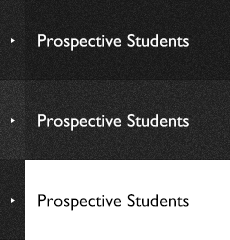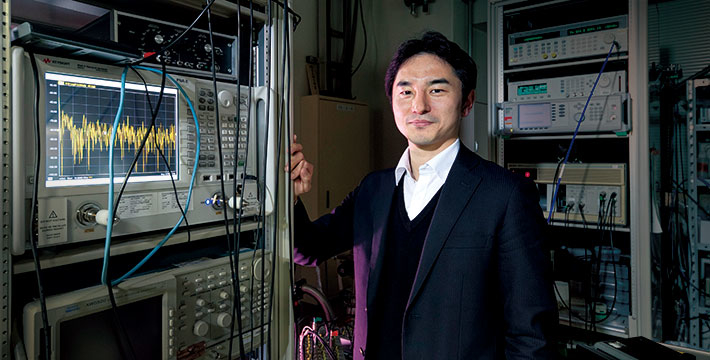
Pursuing foundational technology leading to quantum computers
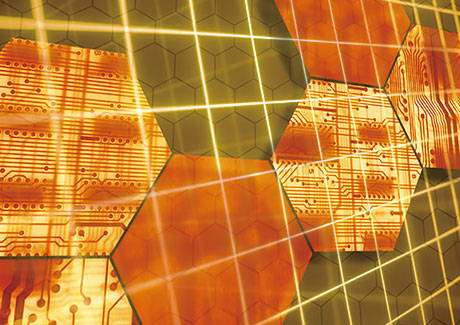
A quantum computer is scheduled to make its first appearance in Japan before the end of fiscal year 2019. The D-Wave quantum computer will be installed in the research center formed by Tokyo Tech and Tohoku University. To date, Tokyo Tech researchers have been accessing a machine installed outside Japan via the cloud. But now progress is being made to join Tokyo Tech's basic research with Tohoku University's applied research, and also cooperate with industry to develop a global research hub. In the field of quantum computers, filled with brilliant, global-scale advances in R&D, Associate Professor Tetsuo Kodera is working to develop foundational technologies using semiconductor silicon. We asked Kodera and two of his students to tell us about the current state of quantum computing and the outlook for its evolution.
What is a quantum computer?
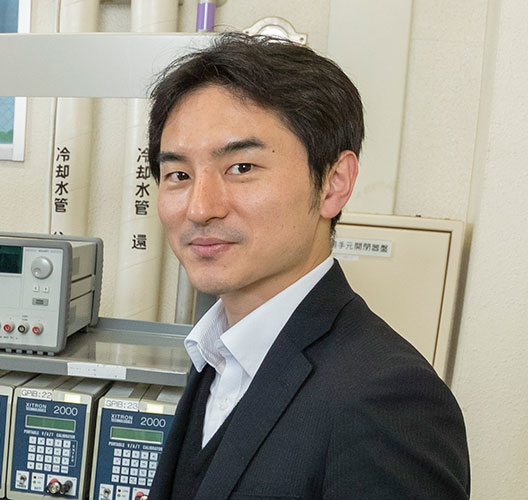
Tetsuo Kodera
Associate Professor, School of Engineering
Faculty of the Department of Electrical and Electronic Engineering
Quantum Computing Unit
Laboratory
Researcher Profile
Graduated from the Department of Physics, Faculty of Science, the University of Tokyo in 2002. Received a master's degree from the Department of Physics, Graduate School of Science, the University of Tokyo in 2004. Received a doctoral degree from the Department of Physics, Graduate School of Science, the University of Tokyo in 2007. Became Adjunct Assistant Professor at the Institute for Nano Quantum Information Electronics at the University of Tokyo in 2007; Assistant Professor at the Quantum Nanoelectronics Research Center at Tokyo Institute of Technology in 2009; and Associate Professor at the Department of Physical Electronics, Graduate School of Science and Engineering in 2014; at current post since 2016. Doctor of Science.
Calculations that would take thousands of years on current supercomputers solved in under a minute. That is what is expected of the quantum computer — a completely new computer using the principles of quantum mechanics, a theory in physics which describes behavior at nanometers (one-millionths of 1 mm) or even more minute scales.
Why would calculations become that much more rapid? Conventional computing machines constructed based on the laws of motion, of classical physics, use a unit called a "bit", representing information in binary, 0 or 1. This is called "classical information," and, using a metaphor of a stone that is white on one side and black on the other, only two states can exist: white or black. Each piece of this information is processed sequentially, meaning that if there is a large amount of information, calculation will take a large amount of time. On the other hand, quantum mechanics can handle superposed states, unclear whether they are white or black (being partly in both states at the same time). Called "quantum information," it uses a unit called the quantum bit (qubit)1, containing both 0 and 1 at the same time. Thus an infinite number of states can exist, and an overwhelming calculation speed is realized by processing all the information at the same time, even for large amounts of information (Figure 1).
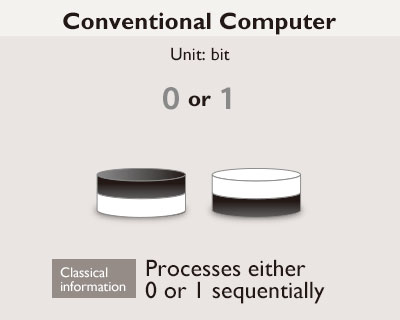
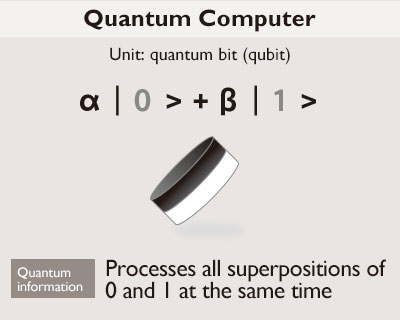
- Figure 1.
- For example, when processing 8 pieces of information, classical information requires a calculation of 3 bits of data (from 000 to 111) eight times. With quantum information, the 8 pieces of information can be collected into one, and can all be processed at the same time in one calculation.
"The evolution of the conventional computer is nearing its limit, and I feel that expectations for the quantum computer have heightened in the last two or three years. Certain types of quantum computers, like IBM Q and D-Wave, have begun to be put to applied use, and we are now at the phase to consider applications and other factors." (Kodera)
Superconductors are a step ahead as the material of quantum computers, an area of fierce R&D. Organizations like Google and NASA are working on their materials. Approaches include photon, cold atom, and ion trap, but what Kodera is focusing on is semiconductor silicon, a material that is receiving as much attention as that for superconductors.
Why make quantum bits out of semiconductor silicon?
A quantum dot2 is a semiconductor that is tens of nanometers in size, and can be thought of as a box in which an electron can be confined and manipulated. It is also called an artificial atom.
Kodera focused on silicon as the material early on and has been developing quantum dot devices. His silicon quantum dot device applies the structure of a metal oxide semiconductor (MOS, Figure 2). Kodera states, "It is compatible with existing silicon technology, and it is well-suited to integration because it resembles a basic MOS transistor. There are three major types of silicon quantum dots. Early on, there was much development in the dopant type, then attention moved to heterojunction-type silicon and silicon-germanium (Si and SiGe), and expectation has risen for this MOS type in recent years."
To produce quantum dots, first, thermal oxidation is used to control the thickness of the silicon-on-insulator (SOI) layer. Next, the components that will become the quantum dot and the gate structure are formed using reactive ion etching3. Then the gate oxide is formed using thermal oxidation and LPCVD4. Following that, a polysilicon top gate is created using LPCVD, photolithography5, and plasma etching6. Then finally, the source and drain are formed. A paper on silicon quantum dots in two-dimensional arrays produced using this method was published in Applied Physics Letters in February 2019 (Figure 3).
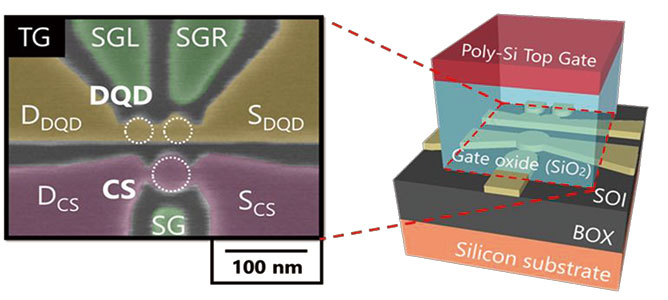
Figure 2. A silicon quantum dot device using the MOS structure
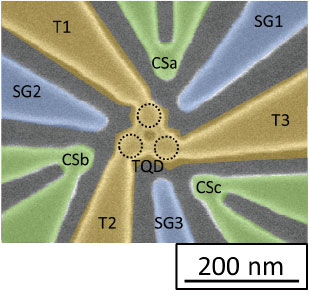
Figure 3. Silicon triple quantum dots
in two-dimensional arrays
Accepted by Applied Physics Letters,
to appear in 2019
The spin of electrons and holes can be controlled with a quantum dot, and the spin, up or down, is used to represent whether the information is 0 or 1. Development of the qubit is to create that the superposed state.
The electron spin and hole spin that represent information are disturbed by mutual interaction with the nuclear spin of the material itself. So preserving their states is difficult. Study on semiconductor spin qubits began about 15 years ago, mainly with gallium arsenide (GaAs). However, it has become clear that GaAs types affect spin qubits because 100% of their nuclei have nuclear spin. Because of this, silicon has attracted attention in recent years, and many researchers are migrating.
"I was using GaAs types as well, when I was a student. But that problem was apparent, so I worked with silicon as soon as I graduated. This is because 95% of silicon does not have nuclear spin. I felt I went a step ahead with the idea of not having information disturbed by nuclear spin." (Kodera)
Increasing the time quantum information can be preserved (coherence time) is one of the major themes. There are many factors that disturb spin and need to be reduced, including magnetic noise, electric noise, and thermal noise. There are diverse approaches being worked on in each aspect — materials, device production, measurement — to reduce noise and to preserve quantum coherence. Among such approaches, silicon has less magnetic noise due to the properties of the material itself. In addition, technologies to form high-quality oxide film and microfabrication of silicon exist and have matured, making it possible to minimize electrical noise in the device compared to other materials. Further, since microfabrication is possible, being able to integrate qubits on a large scale into a size that would fit in a refrigerator is a distinct advantage for future application.
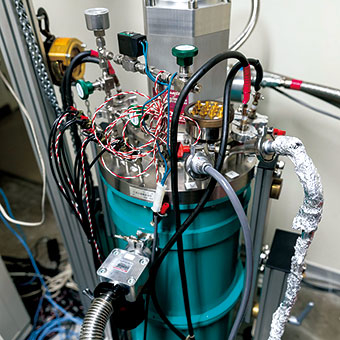
A cryogen-free refrigerator which takes
measurements in an environment of
reduced thermal noise by setting quantum dots
in ultra-low temperatures
(temperatures extremely close to absolute zero)
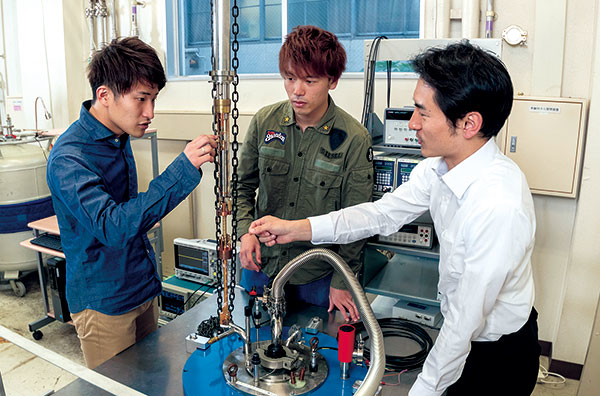
Tetsuo Kodera, Masahiro Tadokoro, and Seiya Mizoguchi prepare
for an experiment to evaluate a quantum bit
at ultra-low temperature. This large refrigerator (2 meters underground) is
used for experiments requiring a large magnetic field.
Partnerships centered on this Tokyo Tech laboratory
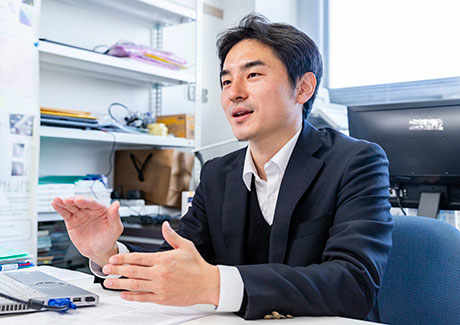
One laboratory's research theme is not expansive enough to develop a quantum computer. "Collaborative research with another group with its own forte" is the stance at Kodera Lab, which has led to valuable relationships with groups inside and outside Japan. Some of its variety of partners have been the University of Tokyo, RIKEN, and the National Institute of Advanced Industrial Science and Technology in Japan, Hitachi Cambridge Laboratory in the United Kingdom, and the Delft University of Technology in the Netherlands.
"For example, the University of New South Wales in Australia has been making huge investments in silicon quantum computers since long ago, and they have produced some wonderful outcomes in recent years. Opportunities for discussion and exchange of opinions with such outstanding researchers can give birth to new ideas. Research by one person is not going to be enough. So I want to be attentive in building human relationships and continue as I have been doing, straight and true." (Kodera)
It is not only materials and devices. Understanding of and cooperation with a wide range of fields, including circuits, system, and software, are also key.
"In carrying out research, the Department of Electrical and Electronic Engineering at Tokyo Tech has an array of professors who are experts in those fields, and it's easy to consult them. I don't know of any other university with so many research fields in one department. Also, large companies have begun to participate in recent years, and the quantum computer is in the process of moving from the physics phase of basic science to the engineering phase with industrialization in view. Engineering to industrialization is Tokyo Tech's forte. Many professors here are experts at that, and I feel that makes for an excellent research environment." (Kodera)
The fact that Professor Hidetoshi Nishimori is at Tokyo Tech is an added boon to research here. Professor Nishimori proposed the use of quantum annealing in quantum computing. Kodera was in an environment which enabled him to participate in the quantum annealing project led by Nishimori and use a quantum annealing machine called D-Wave firsthand. He was able to share information and discuss issues directly. Through this, it occurred to him that perhaps the qubit that he had developed, suitable for the quantum gate method, could also be used for the quantum annealing method. Also concerning the material for the qubit, he started to include superconductors in his research, instead of working only with semiconductors. In describing his outlook, Kodera states, "Until last academic year, we were studying artificial photosynthesis, power devices, and other research related to energy. Now, we are concentrating on the quantum computer only, and all members of the laboratory are working on this. R&D by others is moving fast as well, so I want to focus on this one area and speed things up."
A destined encounter shaping the future
Kodera's research had its beginnings in his time as an undergraduate at UTokyo, where he heard the words "quantum computer" in an applied quantum mechanics class. "It was surprising to me that this perplexing quantum mechanics would be useful in reality and that it could make a computer surpassing the computers we had then. At the same time, I was intrigued," he reminisces. He went to NTT Basic Research Laboratories for a tour, where he was introduced to Professor Seigo Tarucha, and went on to the master's program to join a laboratory. He formed a quantum bit group with an international postdoc and began pursuing his research. After receiving his doctorate, he became a research associate at the Institute for Nano Quantum Information Electronics at the University of Tokyo, in the laboratory of Professor Yasuhiko Arakawa, in April. Then in May, he was sent as a delegate to the United Kingdom. That destination was the Hitachi Cambridge Laboratory.
"That is where I encountered silicon and thought of developing a quantum bit using silicon and spin. Had I not studied under Professor Tarucha and been sent by Professor Arakawa, it may not have become my theme. It was truly a destined encounter." (Kodera)
As if further led by the red string of fate, he met two Tokyo Tech students belonging to Shunri Oda's laboratory who had also visited the Hitachi Cambridge Laboratory. That is how he came to know of Oda Laboratory, his next affiliation as an assistant professor. According to Kodera, he was able to continue researching in cooperation with UTokyo and Hitachi Cambridge thanks to being invited by Professor Oda, who was studying silicon quantum devices. "It was really all a coincidence," he says, shyly.
"And, until the previous academic year, I had the privilege of being a part of Professor Mutsuko Hatano's lab. Professor Hatano radically advanced research in industry before coming to Tokyo Tech as a professor. She taught me how to progress in research from an engineering viewpoint. That view turned out to be indispensable to my work in quantum computers." (Kodera)
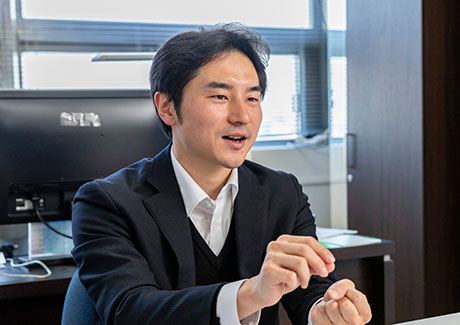
Ten students are currently in Kodera Lab. Openness between faculty and students is fostered through meetings for all members and weekly one-on-one meetings where students can ask about anything. They also socialize through badminton, which Kodera has been playing for over 30 years, social gatherings, and trips taken as a lab. This is all to create a laboratory with good communication.
"In collaborative research with external organizations or in development at a manufacturer, a common path after graduation, I think relationships and trust are important in everything. I make it a point to warn students and point it out to them only when they are lacking in those respects." (Kodera)
Kodera lives by that philosophy himself and has been supported by many encounters since he was a student. "In research, I want students to enjoy the process itself as they take on new challenges. And to facilitate that, it is also important to study the basic academics and liberal arts," he states.
"When I gave a lecture at my old high school, the students there asked so many questions that we went well over time. A master's student who came with me said he was impressed by how they showed such interest. Quantum computers are evolving day by day. I want to further my research, first realizing a highly precise silicon qubit. At the same time, I also want to find a design that suits integration and which has not yet been seen in the silicon field. Our major focus as a lab is the device, but by cooperating with those in connections, circuits, and systems, discussing often, and raising our lab to a much higher stratum, I want to incorporate everything having to do with the quantum computer into our research." (Kodera)
As he spoke, Kodera's eyes reflected his strong determination to create a quantum computer. The future of computing is certainly in his sights.

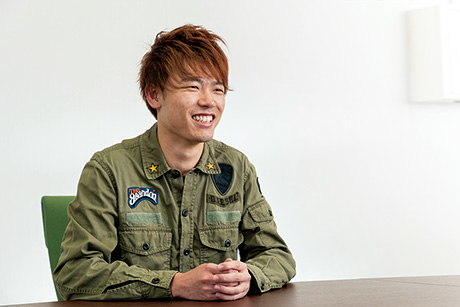
Masahiro Tadokoro
4th year,
Electrical and Electronic Engineering,
School of Engineering
I want to create with my own hands something new that will change the times
I entered the Department of Electrical and Electronic Engineering7 after being shocked by the usefulness of smartphones, which I started using during high school. I wanted to join Kodera Lab because I wanted to research something new, quantum computers. There are many things I don't understand, because it's not a field covered in undergraduate classes. But senior members and Kodera-sensei explain things thoroughly. Kodera-sensei values the experimental process. I have a lot of opportunities to communicate in English, and I feel I can broaden my opportunities. Our current research is to evaluate current characteristics of a device with three quantum dots arranged in a triangle. I hope to continue my research in the master's degree program.
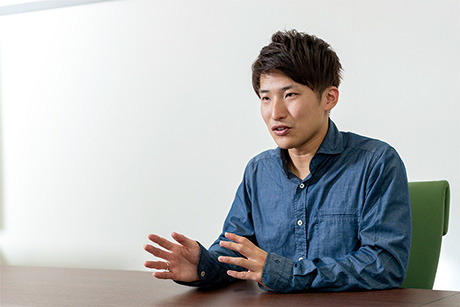
Seiya Mizoguchi
2nd year master's student,
Department of Electrical and Electronic Engineering,
School of Engineering
A lab where you can interact with the technology shouldering the next age
I am researching spin manipulation of charge in quantum dots for realizing spin qubits. It hasn't been realized yet due to issues such as temperature rise due to applying high frequency signals and construction of a measurement system to detect minute signals.8 The interesting part of this research is collecting knowledge by myself and discussing with others to achieve results. I was very interested in the new discipline of quantum mechanics and wanted to enter Kodera Lab by the words "quantum computer." I already knew Kodera-sensei through badminton. He values communication very much. I will leave the university next year to start working, but I wish to keep using the knowledge and skills I have gained at this lab.
1 quantum bit (qubit)
A quantum bit (qubit) is a bit used in quantum computers. It has been implemented in many physical systems, including electron spin and hole spin in a quantum dot.
2 quantum dot
A quantum dot is a structure of microfabricated semiconductor which can confine individual electrons or holes (a hole made by a missing electron).
3 reactive ion etching
One microfabrication technology. To turn a gas into a plasma by applying high-frequency waves and fabricate the semiconductor using ions or radicals.
4 LPCVD
Low-pressure chemical vapor deposition. To deposit a semiconductor film, etc. by supplying a raw material gas which contains the constituent of the film to be deposited.
5 photolithography
The technique of coating with a photosensitive substance and applying light to create a pattern of the exposed portion and the unexposed portion.
6 plasma etching
To etch using a low-temperature gas plasma. It enables concurrent, large-volume processing, simplifying the procedure.
7 the Department of Electrical and Electronic Engineering
The affiliation of entrants for the 2015 academic year and earlier. Those entering for the 2016 academic year and later would belong to the Department of Electrical and Electronic Engineering, School of Engineering.
8 minute signals
To apply voltage or signals to a circuit
Published: July 2019
. Any information published on this site will be valid in relation to Science Tokyo.
















